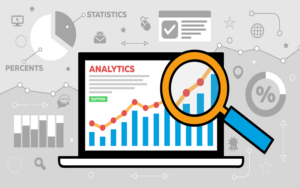
Path to purchase is the process a customer goes through to purchase. Discover customer decision-making strategies & optimize for success.
Your business is constantly looking for ways to understand and optimize your journey from awareness to purchase. This journey, often called the “ path to purchase ”, is an important element of your marketing and sales optimization strategy.
In this blog post, we’ll delve into what your buying journey entails, explore its different stages, and highlight the importance of data analysis to navigate this complex terrain.
Content Index hide
1 What is the path to purchase?
2 The importance of tracking the purchasing journey
3 Stages of the purchasing process
4 Explore the post-purchase stages
5 Influence factors in the purchasing journey
6 Crucial Data Points for Tracking the Buying Journey
7 Difficulties encountered on the path to purchase
8 How to Perform a Path to Purchase Analysis
9 Maximize the buying journey for customer acquisition
10 Buying journey and customer journey
11 Track the purchasing journey with QuestionPro
12 Frequently Asked Questions (FAQ)
What is the path to purchase?
The buying journey, or customer journey or sales funnel , is the journey you embark on when you buy. It takes you through different stages and touchpoints, from the moment you become aware of a product or service to the final purchase and beyond.
It is essential for businesses to understand the different touchpoints in the customer journey, from awareness to loyalty, in order to implement effective marketing strategies and optimize the buying journey institute . This journey is essential for businesses to effectively engage, scale their marketing efforts, and optimize the overall customer experience .
The importance of tracking the purchasing journey
Tracking the purchasing journey is essential in all markets. Understanding how we move from initial awareness to purchase provides valuable insights that can improve marketing strategies and the overall experience to drive business success.
Here are several reasons that highlight the importance of tracking your buying journey:
Gain behavioral insights: Knowing your purchasing behavior allows you to make more informed decisions and understand your preferences. Recognizing influential touchpoints helps you filter and prioritize information, allowing you to make more effective decisions.
Optimize Marketing Strategies: It’s important to carefully consider where you focus your attention and allocate your resources. Knowing which channels speak to you the most is essential to sorting things out and improving the content that really matters.
Personalized Customer Experience: Knowing the stage of your buying process allows you to appreciate and engage with personalized content and interactions. Recognizing the efforts companies or consumer brand marketers make to personalize experiences fosters a stronger connection and greater loyalty.
Identify friction points : By recognizing friction points in the buyer’s journey, you are better equipped to provide feedback and seek solutions. This awareness can help improve the overall customer experience, benefiting both consumers and businesses.
Attribution Modeling: Understanding how you assign value to different customer touchpoints helps you make more informed decisions about where you should focus your attention and resources.
Forecasting and planning: Identifying patterns in your purchasing behavior allows you to plan and budget more effectively. Anticipating future needs based on your past behavior helps in making proactive and strategic decisions.
Customer Retention and Loyalty: As a consumer, recognizing the efforts companies make in post-sales engagement allows you to appreciate and engage with loyalty programs and referrals. Recognizing the value of follow-up communication contributes to a positive cycle of engagement and retention.
Adapt to changing trends: Being aware of your changing behavior allows you to stay ahead of trends and adapt to market changes. This ability to adapt makes you a better informed and more agile consumer.
Stages of the purchasing process
The buying journey , or customer journey , includes the steps consumers take before deciding to purchase. Understanding these steps allows businesses to tailor their strategies for effective engagement and conversion. The common framework includes
Stages of the purchasing process
1. Awareness
In the initial phase of your journey, the main objective is to create awareness among potential customers. It’s about making you aware of a brand, product or service. Key strategies in the awareness phase include:
Content Marketing: Engage with informative content to showcase a brand and address your pain points.
Social Media Presence: Experience brands using social media platforms to connect with a wider audience, share content, and interact with you.
Search engine optimization (SEO): Online content is optimized, making it easier to discover specific brands in search engine results.
Advertising: Announce targeted advertising campaigns, designed to reach your target demographic and increase visibility of your brand.
2. Consideration strategies
Once awareness is established, the focus shifts to providing information to enable consideration of a product or service. The strategies to implement at this stage of reflection are as follows:
Educational content: Access in-depth content highlighting the features, benefits and unique selling points of a product or service.
Customer Testimonials: Read testimonials and reviews from satisfied customers to build trust and credibility.
Email Marketing: Receive targeted email campaigns to pique your interest and provide you with additional information.
Comparison Guides: Explore content comparing products or services, to help you make informed decisions.
3. Master the purchasing phase
Now it’s about guiding you towards closing a deal. The strategies to implement for this last step are as follows:
Clear Call to Action (CTA): Come across websites and marketing materials that feature clear, compelling calls to action designed to guide you toward a purchase.
Simplified checkout process: Experience a streamlined purchasing process, minimizing friction and making transactions easier.
Special Offers and Incentives: Receive discounts, promotions or exclusive offers designed to entice you to purchase immediately.
Trust Signals: Note trust symbols, secure payment options, and transparent policies to inspire confidence in your purchasing decision.
After-Sales Support: Get excellent customer support, order tracking, and follow-up communication to improve your shopping experience.
Explore the post-purchase stages






